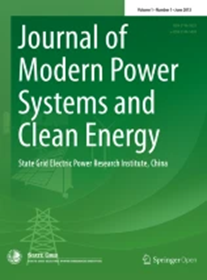一次调频中并网储能逆变器的频率死带控制
IF 6.1
1区 工程技术
Q1 ENGINEERING, ELECTRICAL & ELECTRONIC
Journal of Modern Power Systems and Clean Energy
Pub Date : 2025-01-27
DOI:10.35833/MPCE.2024.000757
引用次数: 0
摘要
随着可再生能源的日益普及,电网形成(GFM)储能(ES)被认为涉及一次频率调节(PFR),通常需要使用频率死带(FDB)来防止过度的电池充电循环和减轻栅极频率振荡。在网格跟踪(GFL)控制中,FDB的实现相对简单。然而,在GFM控制中实现FDB提出了一个重大挑战,因为逆变器必须避免在FDB内的任何频率提供有功功率。因此,本文首先对GFM-ES逆变器中的PFR控制性能进行了详细的分析。在此基础上,采用多种同步方式实现了GFM逆变器的FDB,并考虑了对惯性响应的需求。此外,考虑到FDB边界附近的振荡风险,提出并研究了不同的FDB设置方法,其中提出了一种改进的三角迟滞法,以实现快速响应和增强稳定性。最后通过仿真和实验验证了上述方法的有效性。本文章由计算机程序翻译,如有差异,请以英文原文为准。
Frequency Deadband Control of Grid-forming Energy Storage Inverter in Primary Frequency Regulation
With the increased penetration of renewable energy sources, the grid-forming (GFM) energy storage (ES) has been considered to engage in primary frequency regulation (PFR), often necessitating the use of a frequency deadband (FDB) to prevent excessive battery charging cycling and miti-gate frequency oscillations. Implementing the FDB is relatively straightforward in grid-following (GFL) control. However, implementing the FDB in GFM control presents a significant challenge since the inverter must abstain from providing active power at any frequency within the FDB. Therefore, in this paper, the performance of PFR control in the GFM-ES inverter is analyzed in detail first. Then, the FDB is implemented for GFM inverters with various types of synchronization methods, and the need for inertia response is also considered. Moreover, given the risk of oscillations near the FDB boundary, different FDB setting methods are proposed and examined, where an improved triangular hysteresis method is proposed to realize the fast response and enhanced stability. Finally, the simulation and experiment results are provided to verify the effectiveness of the above methods.
求助全文
通过发布文献求助,成功后即可免费获取论文全文。
去求助
来源期刊

Journal of Modern Power Systems and Clean Energy
ENGINEERING, ELECTRICAL & ELECTRONIC-
CiteScore
12.30
自引率
14.30%
发文量
97
审稿时长
13 weeks
期刊介绍:
Journal of Modern Power Systems and Clean Energy (MPCE), commencing from June, 2013, is a newly established, peer-reviewed and quarterly published journal in English. It is the first international power engineering journal originated in mainland China. MPCE publishes original papers, short letters and review articles in the field of modern power systems with focus on smart grid technology and renewable energy integration, etc.
 求助内容:
求助内容: 应助结果提醒方式:
应助结果提醒方式:


